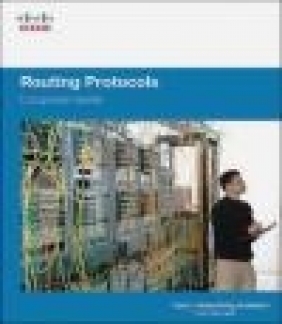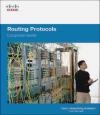Routing Protocols Companion Guide
Cisco Networking Academy
Routing Protocols Companion Guide
Cisco Networking Academy
- Producent: Cisco Press
- Rok produkcji: 2014
- ISBN: 9781587133237
- Ilość stron: 792
- Oprawa: Twarda
Niedostępna
Opis: Routing Protocols Companion Guide - Cisco Networking Academy
Routing Protocols Companion Guide is the official supplemental textbook for the Routing Protocols course in the Cisco(R) Networking Academy(R) CCNA(R) Routing and Switching curriculum. This course describes the architecture, components, and operations of routers, and explains the principles of routing and routing protocols. You learn how to configure a router for basic and advanced functionality. By the end of this course, you will be able to configure and troubleshoot routers and resolve common issues with RIPv1, RIPv2, EIGRP, and OSPF in both IPv4 and IPv6 networks. The Companion Guide is designed as a portable desk reference to use anytime, anywhere to reinforce the material from the course and organize your time. The book's features help you focus on important concepts to succeed in this course: * Chapter objectives-Review core concepts by answering the focus questions listed at the beginning of each chapter. * Key terms-Refer to the lists of networking vocabulary introduced and highlighted in context in each chapter. * Glossary-Consult the comprehensive Glossary with more than 150 terms. * Summary of Activities and Labs-Maximize your study time with this complete list of all associated practice exercises at the end of each chapter. * Check Your Understanding-Evaluate your readiness with the end-of-chapter questions that match the style of questions you see in the online course quizzes. The answer key explains each answer. * How To-Look for this icon to study the steps you need to learn to perform certain tasks. * Interactive Activities-Reinforce your understanding of topics by doing all the exercises from the online course identified throughout the book with this icon. * Videos-Watch the videos embedded within the online course. * Packet Tracer Activities-Explore and visualize networking concepts using Packet Tracer exercises interspersed throughout the chapters. * Hands-on Labs-Work through all the course labs and Class Activities that are included in the course and published in the separate Lab Manual.Introduction xxiv Chapter 1 Routing Concepts 1 Objectives 1 Key Terms 1 Introduction (1.0.1.1) 3 Initial Configuration of a Router (1.1) 4 Characteristics of a Network (1.1.1.1) 4 Why Routing? (1.1.1.2) 5 Routers Are Computers (1.1.1.3) 6 Routers Interconnect Networks (1.1.1.4) 7 Routers Choose Best Paths (1.1.1.5) 9 Packet Forwarding Mechanisms (1.1.1.6) 9 Connect Devices (1.1.2) 12 Connect to a Network (1.1.2.1) 13 Default Gateways (1.1.2.2) 14 Document Network Addressing (1.1.2.3) 15 Enable IP on a Host (1.1.2.4) 16 Device LEDs (1.1.2.5) 18 Console Access (1.1.2.6) 19 Enable IP on a Switch (1.1.2.7) 20 Basic Settings on a Router (1.1.3) 22 Configure Basic Router Settings (1.1.3.1) 22 Configure an IPv4 Router Interface (1.1.3.2) 24 Configure an IPv6 Router Interface (1.1.3.3) 25 Configure an IPv4 Loopback Interface (1.1.3.4) 28 Verify Connectivity of Directly Connected Networks (1.1.4) 29 Verify Interface Settings (1.1.4.1) 29 Verify IPv6 Interface Settings (1.1.4.2) 31 Filter Show Command Output (1.1.4.3) 34 Command History Feature (1.1.4.4) 36 Routing Decisions (1.2) 38 Router Switching Function (1.2.1.1) 38 Send a Packet (1.2.1.2) 39 Forward to the Next Hop (1.2.1.3) 40 Packet Routing (1.2.1.4) 41 Reach the Destination (1.2.1.5) 42 Path Determination (1.2.2) 43 Routing Decisions (1.2.2.1) 43 Best Path (1.2.2.2) 44 Load Balancing (1.2.2.3) 45 Administrative Distance (1.2.2.4) 46 Router Operation (1.3) 47 Analyze the Routing Table (1.3.1) 47 The Routing Table (1.3.1.1) 47 Routing Table Sources (1.3.1.2) 48 Remote Network Routing Entries (1.3.1.3) 49 Directly Connected Routes (1.3.2) 51 Directly Connected Interfaces (1.3.2.1) 51 Directly Connected Route Table Entries (1.3.2.2) 51 Directly Connected Examples (1.3.2.3) 52 Directly Connected IPv6 Example (1.3.2.4) 53 Statically Learned Routes (1.3.3) 56 Static Routes (1.3.3.1) 56 Static Route Examples (1.3.3.2) 57 Static IPv6 Route Examples (1.3.3.3) 59 Dynamic Routing Protocols (1.3.4) 61 Dynamic Routing (1.3.4.1) 61 IPv4 Routing Protocols (1.3.4.2) 62 IPv4 Dynamic Routing Examples (1.3.4.3) 63 IPv6 Routing Protocols (1.3.4.4) 64 IPv6 Dynamic Routing Examples (1.3.4.5) 64 Summary (1.4) 66 Practice 67 Class Activities 67 Labs 67 Packet Tracer Activities 67 Check Your Understanding Questions 68 Chapter 2 Static Routing 73 Objectives 73 Key Terms 73 Introduction (2.0.1.1) 74 Static Routing Implementation (2.1) 75 Reach Remote Networks (2.1.1.1) 75 Why Use Static Routing? (2.1.1.2) 76 When to Use Static Routes (2.1.1.3) 77 Static Route Applications (2.1.2.1) 78 Standard Static Route (2.1.2.2) 79 Default Static Route (2.1.2.3) 79 Summary Static Route (2.1.2.4) 80 Floating Static Route (2.1.2.5) 81 Configure Static and Default Routes (2.2) 82 Configure IPv4 Static Routes (2.2.1) 82 ip route Command (2.2.1.1) 82 Next-Hop Options (2.2.1.2) 84 Configure a Next-Hop Static Route (2.2.1.3) 85 Configure a Directly Connected Static Route (2.2.1.4) 87 Configure a Fully Specified Static Route (2.2.1.5) 89 Verify a Static Route (2.2.1.6) 91 Configure IPv4 Default Routes (2.2.2) 93 Default Static Route (2.2.2.1) 93 Configure a Default Static Route (2.2.2.2) 94 Verify a Default Static Route (2.2.2.3) 94 Configure IPv6 Static Routes (2.2.3) 96 The ipv6 route Command (2.2.3.1) 96 Next-Hop Options (2.2.3.2) 97 Configure a Next-Hop Static IPv6 Route (2.2.3.3) 100 Configure a Directly Connected Static IPv6 Route (2.2.3.4) 102 Configure a Fully Specified Static IPv6 Route (2.2.3.5) 104 Verify IPv6 Static Routes (2.2.3.6) 105 Configure IPv6 Default Routes (2.2.4) 106 Default Static IPv6 Route (2.2.4.1) 106 Configure a Default Static IPv6 Route (2.2.4.2) 107 Verify a Default Static Route (2.2.4.3) 108 Review of CIDR and VLSM (2.3) 109 Classful Addressing (2.3.1) 109 Classful Network Addressing (2.3.1.1) 109 Classful Subnet Masks (2.3.1.2) 110 Classful Routing Protocol Example (2.3.1.3) 112 Classful Addressing Waste (2.3.1.4) 113 CIDR (2.3.2) 114 Classless Inter-Domain Routing (2.3.2.1) 114 Classless Inter-Domain Routing (2.3.2.2) 115 Static Routing CIDR Example (2.3.2.3) 117 Classless Routing Protocol Example (2.3.2.4) 118 VLSM (2.3.3) 119 Fixed-Length Subnet Masking (2.3.3.1) 119 Variable-Length Subnet Masking (2.3.3.2) 121 VLSM in Action (2.3.3.3) 122 Subnetting Subnets (2.3.3.4) 123 VLSM Example (2.3.3.5) 125 Configure Summary and Floating Static Routes (2.4) 128 Configure IPv4 Summary Routes (2.4.1) 128 Route Summarization (2.4.1.1) 128 Calculate a Summary Route (2.4.1.2) 129 Summary Static Route Example (2.4.1.3) 130 Configure IPv6 Summary Routes (2.4.1) 133 Summarize IPv6 Network Addresses (2.4.2.1) 133 Calculate IPv6 Network Addresses (2.4.2.2) 134 Configure an IPv6 Summary Address (2.4.2.3) 137 Configure Floating Static Routes (2.4.3) 138 Floating Static Routes (2.4.3.1) 138 Configure a Floating Static Route (2.4.3.2) 140 Test the Floating Static Route (2.4.3.3) 141 Troubleshoot Static and Default Route Issues (2.5) 142 Packet Processing with Static Routes (2.5.1) 143 Static Routes and Packet Forwarding (2.5.1.1) 143 Troubleshoot IPv4 Static and Default Route Configuration (2.5.2) 144 Troubleshooting a Missing Route (2.5.2.1) 144 Solve a Connectivity Problem (2.5.2.2) 147 Summary (2.6) 150 Practice 151 Class Activities 151 Labs 152 Packet Tracer Activities 152 Check Your Understanding Questions 152 Chapter 3 Routing Dynamically 155 Objectives 155 Key Terms 155 Introduction (3.0.1.1) 157 Dynamic Routing Protocols (3.1) 158 The Evolution of Dynamic Routing Protocols (3.1.1.1) 158 Purpose of Dynamic Routing Protocols (3.1.1.2) 159 The Role of Dynamic Routing Protocols (3.1.1.3) 160 Dynamic versus Static Routing (3.1.2) 161 Using Static Routing (3.1.2.1) 161 Static Routing Scorecard (3.1.2.2) 162 Using Dynamic Routing Protocols (3.1.2.3) 163 Dynamic Routing Scorecard (3.1.2.4) 163 Routing Protocol Operating Fundamentals (3.1.3) 164 Dynamic Routing Protocol Operation (3.1.3.1) 165 Cold Start (3.1.3.2) 165 Network Discovery (3.1.3.3) 166 Exchanging the Routing Information (3.1.3.4) 168 Achieving Convergence (3.1.3.5) 170 Types of Routing Protocols (3.1.4) 171 Classifying Routing Protocols (3.1.4.1) 171 IGP and EGP Routing Protocols (3.1.4.2) 172 Distance Vector Routing Protocols (3.1.4.3) 173 Link-State Routing Protocols (3.1.4.4) 174 Classful Routing Protocols (3.1.4.5) 175 Classless Routing Protocols (3.1.4.6) 177 Routing Protocol Characteristics (3.1.4.7) 179 Routing Protocol Metrics (3.1.4.8) 180 Distance Vector Dynamic Routing (3.2) 181 Distance Vector Technologies (3.2.1.1) 181 Distance Vector Algorithm (3.2.1.2) 182 Types of Distance Vector Routing Protocols (3.2.2) 183 Routing Information Protocol (3.2.2.1) 183 Enhanced Interior Gateway Routing Protocol (3.2.2.2) 184 RIP and RIPng Routing (3.3) 186 Configuring the RIP Protocol (3.3.1) 186 Router RIP Configuration Mode (3.3.1.1) 186 Advertising Networks (3.3.1.2) 188 Examining Default RIP Settings (3.3.1.3) 189 Enabling RIPv2 (3.3.1.4) 190 Disabling Auto Summarization (3.3.1.5) 192 Configuring Passive Interfaces (3.3.1.6) 193 Propagating a Default Route (3.3.1.7) 195 Configuring the RIPng Protocol (3.3.2) 196 Advertising IPv6 Networks (3.3.2.1) 196 Examining the RIPng Configuration (3.3.2.2) 198 Link-State Dynamic Routing (3.4) 200 Link-State Routing Protocol Operation (3.4.1) 200 Shortest Path First Protocols (3.4.1.1) 200 Dijkstra's Algorithm (3.4.1.2) 201 SPF Example (3.4.1.3) 202 Link-State Updates (3.4.2) 203 Link-State Routing Process (3.4.2.1) 203 Link and Link-State (3.4.2.2) 204 Say Hello (3.4.2.3) 207 Building the Link-State Packet (3.4.2.4) 208 Flooding the LSP (3.4.2.5) 209 Building the Link-State Database (3.4.2.6) 210 Building the SPF Tree (3.4.2.7) 211 Adding OSPF Routes to the Routing Table (3.4.2.8) 212 Why Use Link-State Routing Protocols? (3.4.3) 213 Why Use Link-State Protocols? (3.4.3.1) 213 Link-State Protocols Support Multiple Areas (3.4.3.2) 214 Protocols that Use Link-State (3.4.3.3) 214 The Routing Table (3.5) 215 Parts of an IPv4 Route Entry (3.5.1) 215 Routing Table Entries (3.5.1.1) 215 Directly Connected Entries (3.5.1.2) 217 Remote Network Entries (3.5.1.3) 218 Dynamically Learned IPv4 Routes (3.5.2) 219 Routing Table Terms (3.5.2.1) 219 Ultimate Route (3.5.2.2) 220 Level 1 Route (3.5.2.3) 220 Level 1 Parent Route (3.5.2.4) 221 Level 2 Child Route (3.5.2.5) 222 The IPv4 Route Lookup Process (3.5.3) 224 Route Lookup Process (3.5.3.1) 224 Best Route = Longest Match (3.5.3.2) 226 Analyze an IPv6 Routing Table (3.5.4) 227 IPv6 Routing Table Entries (3.5.4.1) 227 Directly Connected Entries (3.5.4.2) 228 Remote IPv6 Network Entries (3.5.4.3) 230 Summary (3.6) 232 Practice 233 Class Activities 233 Lab 233 Packet Tracer Activities 234 Check Your Understanding Questions 234 Chapter 4 EIGRP 239 Objectives 239 Key Terms 239 Introduction (4.0.1) 240 Characteristics of EIGRP (4.1) 240 Basic Features of EIGRP (4.1.1) 240 Features of EIGRP (4.1.1.1) 241 Protocol-Dependent Modules (4.1.1.2) 242 Reliable Transport Protocol (4.1.1.3) 243 Authentication (4.1.1.4) 244 Types of EIGRP Packets (4.1.2) 245 EIGRP Packet Types (4.1.2.1) 245 EIGRP Hello Packets (4.1.2.2) 247 EIGRP Update and Acknowledgment Packets (4.1.2.3) 248 EIGRP Query and Reply Packets (4.1.2.4) 249 EIGRP Messages (4.1.3) 251 Encapsulating EIGRP Messages (4.1.3.1) 251 EIGRP Packet Header and TLV (4.1.3.2) 252 Configuring EIGRP for IPv4 (4.2) 255 Configuring EIGRP with IPv4 (4.2.1) 255 EIGRP Network Topology (4.2.1.1) 255 Autonomous System Numbers (4.2.1.2) 257 The Router EIGRP Command (4.2.1.3) 259 EIGRP Router ID (4.2.1.4) 261 Configuring the EIGRP Router ID (4.2.1.5) 262 The Network Command (4.2.1.6) 264 The Network Command and Wildcard Mask (4.2.1.7) 266 Passive Interface (4.2.1.8) 268 Verifying EIGRP with IPv4 (4.2.2) 270 Verifying EIGRP: Examining Neighbors (4.2.2.1) 270 Verifying EIGRP: show ip protocols Command (4.2.2.2) 272 Verifying EIGRP: Examine the IPv4 Routing Table (4.2.2.3) 273 Operation of EIGRP (4.3) 277 EIGRP Initial Route Discover (4.3.1) 277 EIGRP Neighbor Adjacency (4.3.1.1) 277 EIGRP Topology Table (4.3.1.2) 278 EIGRP Convergence (4.3.1.3) 280 Metrics (4.3.2) 280 EIGRP Composite Metric (4.3.2.1) 281 Examining Interface Values (4.3.2.2) 283 Bandwidth Metric (4.3.2.3) 284 Delay Metric (4.3.2.4) 286 Calculating the EIGRP Metric (4.3.2.5) 287 Calculating the EIGRP Metric: Example (4.3.2.6) 288 DUAL and the Topology Table (4.3.3) 290 DUAL Concepts (4.3.3.1) 291 Introduction to DUAL (4.3.3.2) 291 Successor and Feasible Distance (4.3.3.3) 293 Feasible Successors, Feasibility Condition, and Reported Distance (4.3.3.4) 295 Topology Table: show ip eigrp topology Command (4.3.3.5) 297 Topology Table: No Feasible Successor (4.3.3.7) 300 DUAL and Convergence (4.3.4) 302 DUAL Finite State Machine (FSM) (4.3.4.1) 302 DUAL: Feasible Successor (4.3.4.2) 304 DUAL: No Feasible Successor (4.3.4.3) 306 Configuring EIGRP for IPv6 (4.4) 308 EIGRP for IPv4 vs. IPv6 (4.4.1) 308 EIGRP for IPv6 (4.4.1.1) 308 Comparing EIGRP for IPv4 and IPv6 (4.4.1.2) 310 IPv6 Link-local Addresses (4.4.1.3) 311 Configuring EIGRP for IPv6 (4.4.2) 312 EIGRP for IPv6 Network Topology (4.4.2.1) 312 Configuring IPv6 Link-local Addresses (4.4.2.2) 314 Configuring the EIGRP for IPv6 Routing Process (4.4.2.3) 316 ipv6 eigrp Interface Command (4.4.2.4) 318 Verifying EIGRP for IPv6 (4.4.3) 319 Verifying EIGRP for IPv6: Examining Neighbors (4.4.3.1) 319 Verifying EIGRP for IPv6: show ip protocols Command (4.4.3.2) 321 Verifying EIGRP for IPv6: Examine the IPv6 Routing Table (4.4.3.3) 322 Summary (4.5) 326 Practice 327 Class Activities 328 Labs 328 Packet Tracer Activities 328 Check Your Understanding Questions 328 Chapter 5 EIGRP Advanced Configurations and Troubleshooting 333 Objectives 333 Key Terms 333 Introduction (5.0.1.1) 334 Advanced EIGRP Configurations (5.1) 334 Auto-summarization (5.1.1) 335 Network Topology (5.1.1.1) 335 EIGRP Auto-summarization (5.1.1.2) 337 Configuring EIGRP Auto-summarization (5.1.1.3) 338 Verifying Auto-Summary: show ip protocols (5.1.1.4) 340 Verifying Auto-Summary: Topology Table (5.1.1.5) 342 Verifying Auto-Summary: Routing Table (5.1.1.6) 343 Summary Route (5.1.1.7, 5.1.1.8) 345 Manual Summarization (5.1.2) 347 Manual Summary Routes (5.1.2.1) 347 Configuring EIGRP Manual Summary Routes (5.1.2.2) 349 Verifying Manual Summary Routes (5.1.2.3) 351 EIGRP for IPv6: Manual Summary Routes (5.1.2.4) 351 Default Route Propagation (5.1.3) 353 Propagating a Default Static Route (5.1.3.1) 353 Verifying the Propagated Default Route (5.1.3.2) 355 EIGRP for IPv6: Default Route (5.1.3.3) 355 Fine-tuning EIGRP Interfaces (5.1.4) 357 EIGRP Bandwidth Utilization (5.1.4.1) 357 Hello and Hold Timers (5.1.4.2) 359 Load Balancing IPv4 (5.1.4.3) 361 Load Balancing IPv6 (5.1.4.4) 363 Secure EIGRP (5.1.5) 364 Routing Protocol Authentication Overview (5.1.5.1) 364 Configuring EIGRP with MD5 Authentication (5.1.5.2) 365 EIGRP Authentication Example (5.1.5.3) 366 Verify Authentication (5.1.5.4) 369 Troubleshoot EIGRP (5.2) 370 Components of Troubleshooting EIGRP (5.2.1) 370 Basic EIGRP Troubleshooting Commands (5.2.1.1) 370 Components (5.2.1.2) 372 Troubleshoot EIGRP Neighbor Issues (5.2.2) 374 Layer 3 Connectivity (5.2.2.1) 374 EIGRP Parameters (5.2.2.2) 375 EIGRP Interfaces (5.2.2.3) 376 Troubleshooting EIGRP Routing Table Issues (5.2.3) 378 Passive Interface (5.2.3.1) 378 Missing Network Statement (5.2.3.2) 380 Auto-summarization (5.2.3.3) 382 Summary (5.3) 386 Practice 388 Class Activities 388 Labs 388 Packet Tracer Activities 388 Check Your Understanding Questions 389 Chapter 6 Single-Area OSPF 393 Objectives 393 Key Terms 393 Introduction (6.0.1.1) 394 Characteristics of OSPF (6.1) 394 Evolution of OSPF (6.1.1.1) 394 Features of OSPF (6.1.1.2) 395 Components of OSPF (6.1.1.3) 396 Link-State Operation (6.1.1.4) 398 Single-Area and Multiarea OSPF (6.1.1.5) 399 OSPF Messages (6.1.2) 401 Encapsulating OSPF Messages (6.1.2.1) 402 Types of OSPF Packets (6.1.2.2) 402 Hello Packet (6.1.2.3) 403 Hello Packet Intervals (6.1.2.4) 404 Link-State Updates (6.1.2.5) 405 OSPF Operation (6.1.3) 406 OSPF Operational States (6.1.3.1) 406 Establish Neighbor Adjacencies (6.1.3.2) 407 OSPF DR and BDR (6.1.3.3) 408 Synchronizing OSPF Databases (6.1.3.4) 411 Configuring Single-Area OSPFv2 (6.2) 414 OSPF Network Topology (6.2.1.1) 414 Router OSPF Configuration Mode (6.2.1.2) 415 Router IDs (6.2.1.3) 415 Configuring an OSPF Router ID (6.2.1.4) 417 Modifying a Router ID (6.2.1.5) 418 Using a Loopback Interface as the Router ID (6.2.1.6) 419 Configure Single-Area OSPFv2 (6.2.2) 420 Enabling OSPF on Interfaces (6.2.2.1) 420 Wildcard Mask (6.2.2.2) 420 The network Command (6.2.2.3) 421 Passive Interface (6.2.2.4) 422 Configuring Passive Interfaces (6.2.2.5) 423 OSPF Cost (6.2.3) 425 OSPF Metric = Cost (6.2.3.1) 425 OSPF Accumulates Costs (6.2.3.2) 426 Adjusting the Reference Bandwidth (6.2.3.3) 427 Default Interface Bandwidths (6.2.3.4) 430 Adjusting the Interface Bandwidths (6.2.3.5) 433 Manually Setting the OSPF Cost (6.2.3.6) 434 Verify OSPF (6.2.4) 435 Verify OSPF Neighbors (6.2.4.1) 435 Verify OSPF Protocol Settings (6.2.4.2) 436 Verify OSPF Process Information (6.2.4.3) 437 Verify OSPF Interface Settings (6.2.4.4) 438 Configure Single-Area OSPFv3 (6.3) 439 OSPFv3 (6.3.1.1) 439 Similarities Between OSPFv2 and OSPFv3 (6.3.1.2) 440 Differences Between OSPFv2 and OSPFv3 (6.3.1.3) 441 Link-Local Addresses (6.3.1.4) 442 Configuring OSPFv3 (6.3.2) 443 OSPFv3 Network Topology (6.3.2.1) 443 Link-Local Addresses (6.3.2.2) 444 Assigning Link-Local Addresses (6.3.2.3) 445 Configuring the OSPFv3 Router ID (6.3.2.4) 446 Modifying an OSPFv3 Router ID (6.3.2.5) 449 Enabling OSPFv3 on Interfaces (6.3.2.6) 450 Verify OSPFv3 (6.3.3) 451 Verify OSPFv3 Neighbors (6.3.3.1) 451 Verify OSPFv3 Protocol Settings (6.3.3.2) 452 Verify OSPFv3 Interfaces (6.3.3.3) 453 Verify the IPv6 Routing Table (6.3.3.4) 453 Summary (6.4) 455 Practice 456 Class Activities 456 Labs 456 Packet Tracer Activities 456 Check Your Understanding Questions 457 Chapter 7 Adjust and Troubleshoot Single-Area OSPF 461 Objectives 461 Key Terms 461 Introduction (7.0.1.1) 462 Advanced Single-Area OSPF Configurations (7.1) 462 OSPF Network Types (7.1.1.1) 462 Challenges in Multiaccess Networks (7.1.1.2) 465 OSPF Designated Router (7.1.1.3) 467 Verifying DR/BDR Roles (7.1.1.4) 469 Verifying DR/BDR Adjacencies (7.1.1.5) 472 Default DR/BDR Election Process (7.1.1.6) 474 DR/BDR Election Process (7.1.1.7) 475 The OSPF Priority (7.1.1.8) 477 Changing the OSPF Priority (7.1.1.9) 478 Default Route Propagation (7.1.2) 480 Propagating a Default Static Route in OSPFv2 (7.1.2.1) 480 Verifying the Propagated Default Route (7.1.2.2) 481 Propagating a Default Static Route in OSPFv3 (7.1.2.3) 482 Verifying the Propagated IPv6 Default Route (7.1.2.4) 484 Fine-tuning OSPF Interfaces (7.1.3) 485 OSPF Hello and Dead Intervals (7.1.3.1) 485 Modifying OSPFv2 Intervals (7.1.3.2) 486 Modifying OSPFv3 Intervals (7.1.3.3) 488 Secure OSPF (7.1.4) 489 Routers Are Targets (7.1.4.1) 489 Secure Routing Updates (7.1.4.2) 492 MD5 Authentication (7.1.4.3) 495 Configuring OSPF MD5 Authentication (7.1.4.4) 496 OSPF MD5 Authentication Example (7.1.4.5) 497 Verifying OSPF MD5 Authentication (7.1.4.6) 499 Troubleshooting Single-Area OSPF Implementations (7.2) 501 OSPF States (7.2.1.2) 501 OSPF Troubleshooting Commands (7.2.1.3) 502 Components of Troubleshooting OSPF (7.2.1.4) 505 Troubleshoot Single-Area OSPFv2 Routing Issues (7.2.2) 508 Troubleshooting Neighbor Issues (7.2.2.1) 508 Troubleshooting OSPF Routing Table Issues (7.2.2.2) 511 Troubleshoot Single-Area OSPFv3 Routing Issues (7.2.3) 514 OSPFv3 Troubleshooting Commands (7.2.3.1) 514 Troubleshooting OSPFv3 (7.2.3.2) 517 Summary (7.3) 521 Practice 523 Class Activities 523 Labs 523 Packet Tracer Activities 523 Check Your Understanding Questions 524 Chapter 8 Multiarea OSPF 527 Objectives 527 Key Terms 527 Introduction (8.0.1.1) 528 Multiarea OSPF Operation (8.1) 528 Single-Area OSPF (8.1.1.1) 528 Multiarea OSPF (8.1.1.2) 529 OSPF Two-Layer Area Hierarchy (8.1.1.3) 530 Types of OSPF Routers (8.1.1.4) 532 Multiarea OSPF LSA Operation (8.1.2) 534 OSPF LSA Types (8.1.2.1) 534 OSPF LSA Type 1 (8.1.2.2) 535 OSPF LSA Type 2 (8.1.2.3) 536 OSPF LSA Type 3 (8.1.2.4) 536 OSPF LSA Type 4 (8.1.2.5) 537 OSPF LSA Type 5 (8.1.2.6) 538 OSPF Routing Table and Types of Routes (8.1.3) 539 OSPF Routing Table Entries (8.1.3.1) 539 OSPF Route Calculation (8.1.3.2) 540 Configuring Multiarea OSPF (8.2) 541 Implementing Multiarea OSPF (8.2.1.1) 541 Configuring Multiarea OSPF (8.2.1.2) 542 Configuring Multiarea OSPFv3 (8.2.1.3) 544 OSPF Route Summarization (8.2.2.1) 545 Interarea and External Route Summarization (8.2.2.2) 546 Interarea Route Summarization (8.2.2.3) 548 Calculating the Summary Route (8.2.2.4) 550 Configuring Interarea Route Summarization (8.2.2.5) 550 Verifying Multiarea OSPF (8.2.3.1) 552 Verify General Multiarea OSPF Settings (8.2.3.2) 553 Verify the OSPF Routes (8.2.3.3) 554 Verify the Multiarea OSPF LSDB (8.2.3.4) 555 Verify Multiarea OSPFv3 (8.2.3.5) 556 Summary (8.3) 560 Practice 562 Class Activities 562 Labs 562 Packet Tracer Activities 562 Check Your Understanding Questions 562 Chapter 9 Access Control Lists 565 Objectives 565 Key Terms 565 Introduction (9.0.1.1) 566 IP ACL Operation (9.1) 567 Purpose of ACLs (9.1.1) 567 What Is an ACL? (9.1.1.1) 567 A TCP Conversation (9.1.1.2) 568 Packet Filtering (9.1.1.3) 572 Packet Filtering Example (9.1.1.4) 573 ACL Operation (9.1.1.5) 574 Standard Versus Extended IPv4 ACLs (9.1.2) 575 Types of Cisco IPv4 ACLs (9.1.2.1) 575 Numbering and Naming ACLs (9.1.2.2) 576 Wildcard Masks in ACLs (9.1.3) 577 Introducing ACL Wildcard Masking (9.1.3.1) 577 Wildcard Mask Examples (9.1.3.2) 579 Calculating the Wildcard Mask (9.1.3.3) 581 Wildcard Mask Keywords (9.1.3.4) 582 Examples Wildcard Mask Keywords (9.1.3.5) 584 Guidelines for ACL Creation (9.1.4) 584 General Guidelines for Creating ACLs (9.1.4.1) 585 ACL Best Practices (9.1.4.2) 586 Guidelines for ACL Placement (9.1.5) 587 Where to Place ACLs (9.1.5.1) 587 Standard ACL Placement (9.1.5.2) 588 Extended ACL Placement (9.1.5.3) 589 Standard IPv4 ACLs (9.2) 591 Configure Standard IPv4 ACLs (9.2.1) 591 Entering Criteria Statements (9.2.1.1) 591 Standard ACL Logic (9.2.1.2) 592 Configuring a Standard ACL (9.2.1.3) 593 Internal Logic (9.2.1.4) 595 Applying Standard ACLs to Interfaces: Permit a Specific Subnet (9.2.1.5) 596 Applying Standard ACLs to Interfaces: Deny a Specific Host (9.2.1.6) 598 Creating Named Standard ACLs (9.2.1.7) 600 Commenting ACLs (9.2.1.8) 601 Modifying IPv4 ACLs (9.2.2) 603 Editing Standard Numbered ACLs: Using a Text Editor (9.2.2.1) 603 Editing Standard Numbered ACLs: Using the Sequence Number (9.2.2.2) 604 Editing Standard Named ACLs (9.2.2.3) 605 Verifying ACLs (9.2.2.4) 606 ACL Statistics (9.2.2.5) 607 Standard ACL Sequence Numbers (9.2.2.6) 608 Securing VTY Ports with a Standard IPv4 ACL (9.2.3) 611 Configuring a Standard ACL to Secure a VTY Port (9.2.3.1) 611 Verifying a Standard ACL Used to Secure a VTY Port (9.2.3.2) 612 Extended IPv4 ACLs (9.3) 614 Structure of an Extended IPv4 ACL (9.3.1) 614 Extended ACLs: Testing Packets (9.3.1.1) 614 Extended ACLs: Testing Ports and Services (9.3.1.2) 615 Configure Extended IPv4 ACLs (9.3.2) 616 Configuring Extended ACLs (9.3.2.1) 616 Applying Extended ACLs to Interfaces (9.3.2.2) 618 Filtering Traffic with Extended ACLs (9.3.2.3) 620 Creating Named Extended ACLs (9.3.2.4) 621 Verifying Extended ACLs (9.3.2.5) 622 Editing Extended ACLs (9.3.2.6) 623 Troubleshoot ACLs (9.4) 625 Processing Packets with ACLs (9.4.1) 625 Inbound and Outbound ACL Logic (9.4.1.1) 625 ACL Logic Operations (9.4.1.2) 627 Standard ACL Decision Process (9.4.1.3) 628 Extended ACL Decision Process (9.4.1.4) 629 Common ACL Errors (9.4.2) 629 Troubleshooting Common ACL Errors - Example 1 (9.4.2.1) 629 Troubleshooting Common ACL Errors - Example 2 (9.4.2.2) 630 Troubleshooting Common ACL Errors - Example 3 (9.4.2.3) 632 Troubleshooting Common ACL Errors - Example 4 (9.4.2.4) 632 Troubleshooting Common ACL Errors - Example 5 (9.4.2.5) 633 IPv6 ACLs (9.5) 635 IPv6 ACL Creation (9.5.1) 635 Type of IPv6 ACLs (9.5.1.1) 635 Comparing IPv4 and IPv6 ACLs (9.5.1.2) 636 Configuring IPv6 ACLs (9.5.2) 637 Configuring IPv6 Topology (9.5.2.1) 637 Syntax for Configuring IPv6 ACLs (9.5.2.2) 639 Applying an IPv6 ACL to an Interface (9.5.2.3) 641 IPv6 ACL Examples (9.5.2.4) 642 Verifying IPv6 ACLs (9.5.2.5) 643 Summary (9.6) 646 Practice 648 Class Activities 648 Labs 648 Packet Tracer Activities 648 Check Your Understanding Questions 649 Chapter 10 IOS Images and Licensing 653 Objectives 653 Key Terms 653 Introduction (10.0.1.1) 654 Managing IOS System Files (10.1) 654 Naming Conventions (10.1.1) 654 Cisco IOS Software Release Families and Trains (10.1.1.1) 655 Cisco IOS 12.4 Mainline and T Trains (10.1.1.2) 655 Cisco IOS 12.4 Mainline and T Numbering (10.1.1.3) 657 Cisco IOS 12.4 System Image Packaging (10.1.1.4) 658 Cisco IOS 15.0 M and T Trains (10.1.1.5) 659 Cisco IOS 15 Train Numbering (10.1.1.6) 661 IOS 15 System Image Packaging (10.1.1.7) 662 IOS Image Filenames (10.1.1.8) 663 Managing Cisco IOS Images (10.1.2) 667 TFTP Servers as a Backup Location (10.1.2.1) 667 Creating Cisco IOS Image Backup (10.1.2.2) 667 Copying a Cisco IOS Image (10.1.2.3) 669 Boot System (10.1.2.4) 670 IOS Licensing (10.2) 672 Software Licensing (10.2.1) 672 Licensing Overview (10.2.1.1) 672 Licensing Process (10.2.1.2) 674 Step 1. Purchase the Software Package or Feature to Install (10.2.1.3) 675 Step 2. Obtain a License (10.2.1.4) 675 Step 3. Install the License (10.2.1.5) 677 License Verification and Management (10.2.2) 678 License Verification (10.2.2.1) 678 Activate an Evaluation Right-To-Use License (10.2.2.2) 680 Back Up the License (10.2.2.3) 682 Uninstall the License (10.2.2.4) 682 Summary (10.3) 685 Practice 688 Class Activities 688 Packet Tracer Activities 688 Check Your Understanding Questions 688 Appendix A Answers to the "Check Your Understanding" Questions 693 Glossary 709 9781587133237, TOC, 1/24/2014
Szczegóły: Routing Protocols Companion Guide - Cisco Networking Academy
Tytuł: Routing Protocols Companion Guide
Autor: Cisco Networking Academy
Producent: Cisco Press
ISBN: 9781587133237
Rok produkcji: 2014
Ilość stron: 792
Oprawa: Twarda
Waga: 1.54 kg
Recenzje: Routing Protocols Companion Guide - Cisco Networking Academy
Informacje:
Inne pozycje tego autora: Cisco Networking Academy (6)
- Packet Tracer 6 dla kursów CISCO Z przykładami i ćwiczeniami Tom 1 (Itstart) - Miękka
- Packet Tracer dla kursów CISCO Z przykładami i ćwiczeniami Tom 4 (Itstart) - Miękka
- Computer Networks In Packet Tracer For Beginners (Itstart) - miękka
- Computer Networks In Packet Tracer For Advanced Users (Itstart) - miękka
- Packet Tracer For Young Advanced Admins (Itstart) - miękka
- Packet Tracer For Young Beginning Admins (Itstart) - miękka






























